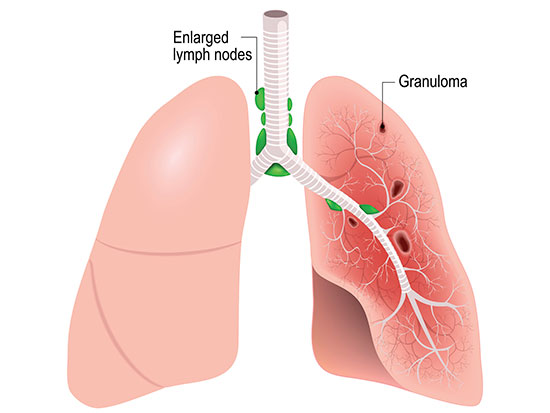 Nirav Patel, M.D. Physician-scientists from the University of Alabama at Birmingham using “big-data” recently summarized in the Journal of the American Heart Association the prevalence of cardiovascular manifestations, rates of defibrillator placement (ICD) and predictors of in-hospital mortality in sarcoidosis — a disorder that affects multiple organs.
Nirav Patel, M.D. Physician-scientists from the University of Alabama at Birmingham using “big-data” recently summarized in the Journal of the American Heart Association the prevalence of cardiovascular manifestations, rates of defibrillator placement (ICD) and predictors of in-hospital mortality in sarcoidosis — a disorder that affects multiple organs.
Sarcoidosis is a systemic illness with a strong propensity to involve the cardiovascular system. It is the growth of tiny collections of inflammatory cells — granulomas — in different parts of the body, most commonly the lungs, lymph nodes, eyes and skin. Utilizing the largest in-patient database — the National Inpatient Sample — a team of researchers from UAB identified more than half a million sarcoidosis hospitalizations without any present or past history of ischemic heart disease from 2005 through 2014 in the United States.
“In view of the gaps in the existing literature base, a retrospective study was conducted to determine trends of hospitalizations and outcomes in sarcoidosis during 2005-2014,” said UAB’s Nirav Patel, M.D. “Furthermore, we examined rates of ICD, cardiac resynchronization therapy, permanent pacemaker placement, and factors associated with in-hospital mortality. We also examined racial disparities in outcomes in sarcoidosis hospitalizations in a propensity matched subgroup.”
Patel, first author of the Journal of the American Heart Association piece, designed and conducted the analyses for the study.
“In previously conducted studies, there was a lack of assessment of the prevalence of cardiovascular manifestations, and trends of ICD implantation in sarcoidosis hospitalizations,” Patel said. “Sarcoidosis with naturally accompanying cardiovascular manifestations has more complications, and a greater risk of sudden death. Thus, there is a considerable interest in identifying sarcoidosis with naturally accompanying cardiovascular manifestations.”
 Sarcoidosis is the growth of tiny collections of inflammatory cells - granulomas - in different parts of the body, most commonly the lungs, lymph nodes, eyes and skin. Researchers have found the rate of hospitalization for sarcoidosis has increased, and in-hospital mortality associated with sarcoidosis decreased from 2005 to 2014. Heart failure and arrhythmias were the most prevalent cardiovascular manifestations in sarcoidosis, followed by pulmonary hypertension, non-ischemic cardiomyopathy and conduction disorder. Conversely, increasing hospitalizations with sarcoidosis, rates of ICD implantations were low — less than 1 percent — and have not shown any upward trend from 2005 through 2014.
Sarcoidosis is the growth of tiny collections of inflammatory cells - granulomas - in different parts of the body, most commonly the lungs, lymph nodes, eyes and skin. Researchers have found the rate of hospitalization for sarcoidosis has increased, and in-hospital mortality associated with sarcoidosis decreased from 2005 to 2014. Heart failure and arrhythmias were the most prevalent cardiovascular manifestations in sarcoidosis, followed by pulmonary hypertension, non-ischemic cardiomyopathy and conduction disorder. Conversely, increasing hospitalizations with sarcoidosis, rates of ICD implantations were low — less than 1 percent — and have not shown any upward trend from 2005 through 2014.
Additionally, African-American race was found to be significantly associated with in-hospital mortality. In an adjusted analysis, African-Americans with sarcoidosis had higher in-hospital mortality and cardiac arrest compared with Caucasians.
“On the most basic level, we hope to inform clinicians that the co-occurrence of cardiovascular manifestations in sarcoidosis is devastating and could be a leading cause of death,” said senior author Pankaj Arora M.D., assistant professor in the Division of Cardiovascular Disease. “Our investigation highlights that aggressive primary and secondary prevention of co-morbid cardiovascular and pulmonary conditions is critical for patients with sarcoidosis, and it serves as a stark reminder of the need to aggressively pursue the preventive measures to improve longstanding cardiovascular racial disparities.”
Authors emphasized that clinicians and investigators alike carry an important responsibility to proactively investigate sarcoidosis with cardiovascular manifestations.
